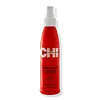What's inside
What's inside
 Key Ingredients
Key Ingredients

 Benefits
Benefits

 Concerns
Concerns

 Ingredients Side-by-side
Ingredients Side-by-side

Water
Skin ConditioningSodium Polystyrene Sulfonate
Emulsion StabilisingAlcohol Denat.
AntimicrobialPropanediol
SolventPolysorbate 20
EmulsifyingHydrolyzed Silk
HumectantPhenoxyethanol
PreservativeCaprylyl Glycol
EmollientHexylene Glycol
EmulsifyingPotassium Sorbate
PreservativeHydrolyzed Wheat Protein Pg-Propyl Silanetriol
Skin ConditioningPPG-20 Methyl Glucose Ether
Skin ConditioningParfum
MaskingBenzyl Benzoate
AntimicrobialButylphenyl Methylpropional
PerfumingHydroxyisohexyl 3-Cyclohexene Carboxaldehyde
MaskingHexyl Cinnamal
PerfumingSilica
AbrasiveAlumina
AbrasiveTitanium Dioxide
Cosmetic ColorantCitric Acid
BufferingWater, Sodium Polystyrene Sulfonate, Alcohol Denat., Propanediol, Polysorbate 20, Hydrolyzed Silk, Phenoxyethanol, Caprylyl Glycol, Hexylene Glycol, Potassium Sorbate, Hydrolyzed Wheat Protein Pg-Propyl Silanetriol, PPG-20 Methyl Glucose Ether, Parfum, Benzyl Benzoate, Butylphenyl Methylpropional, Hydroxyisohexyl 3-Cyclohexene Carboxaldehyde, Hexyl Cinnamal, Silica, Alumina, Titanium Dioxide, Citric Acid
Water
Skin ConditioningDipropylene Glycol
HumectantPhenoxyethanol
PreservativeButylene Glycol
HumectantCaprylyl Glycol
EmollientPolysilicone-29
PEG-12 Dimethicone
Skin ConditioningSilicone Quaternium-18
EmollientCetrimonium Chloride
AntimicrobialTrideceth-6
EmulsifyingParfum
MaskingQuaternium-80
Propylene Glycol
HumectantTrideceth-12
EmulsifyingGlycolic Acid
BufferingIsopentyldiol
HumectantCitric Acid
BufferingBetaine
HumectantGlycerin
HumectantPanax Ginseng Root Extract
EmollientSodium Hyaluronate
HumectantBHT
AntioxidantPunica Granatum Fruit Extract
AntioxidantPotassium Sorbate
PreservativeMethyl Benzoate
PerfumingSorbic Acid
PreservativeBenzyl Salicylate
PerfumingLimonene
PerfumingWater, Dipropylene Glycol, Phenoxyethanol, Butylene Glycol, Caprylyl Glycol, Polysilicone-29, PEG-12 Dimethicone, Silicone Quaternium-18, Cetrimonium Chloride, Trideceth-6, Parfum, Quaternium-80, Propylene Glycol, Trideceth-12, Glycolic Acid, Isopentyldiol, Citric Acid, Betaine, Glycerin, Panax Ginseng Root Extract, Sodium Hyaluronate, BHT, Punica Granatum Fruit Extract, Potassium Sorbate, Methyl Benzoate, Sorbic Acid, Benzyl Salicylate, Limonene
Ingredients Explained
These ingredients are found in both products.
Ingredients higher up in an ingredient list are typically present in a larger amount.
Caprylyl Glycol is a humectant and emollient, meaning it attracts and preserves moisture.
It is a common ingredient in many products, especially those designed to hydrate skin. The primary benefits are retaining moisture, skin softening, and promoting a healthy skin barrier.
Though Caprylyl Glycol is an alcohol derived from fatty acids, it is not the kind that can dry out skin.
This ingredient is also used as a preservative to extend the life of products. It has slight antimicrobial properties.
Learn more about Caprylyl GlycolCitric Acid is an alpha hydroxy acid (AHA) naturally found in citrus fruits like oranges, lemons, and limes.
Like other AHAs, citric acid can exfoliate skin by breaking down the bonds that hold dead skin cells together. This helps reveal smoother and brighter skin underneath.
However, this exfoliating effect only happens at high concentrations (20%) which can be hard to find in cosmetic products.
Due to this, citric acid is usually included in small amounts as a pH adjuster. This helps keep products slightly more acidic and compatible with skin's natural pH.
In skincare formulas, citric acid can:
While it can provide some skin benefits, research shows lactic acid and glycolic acid are generally more effective and less irritating exfoliants.
Most citric acid used in skincare today is made by fermenting sugars (usually from molasses). This synthetic version is identical to the natural citrus form but easier to stabilize and use in formulations.
Read more about some other popular AHA's here:
Learn more about Citric AcidParfum is a catch-all term for an ingredient or more that is used to give a scent to products.
Also called "fragrance", this ingredient can be a blend of hundreds of chemicals or plant oils. This means every product with "fragrance" or "parfum" in the ingredients list is a different mixture.
For instance, Habanolide is a proprietary trade name for a specific aroma chemical. When used as a fragrance ingredient in cosmetics, most aroma chemicals fall under the broad labeling category of “FRAGRANCE” or “PARFUM” according to EU and US regulations.
The term 'parfum' or 'fragrance' is not regulated in many countries. In many cases, it is up to the brand to define this term.
For instance, many brands choose to label themselves as "fragrance-free" because they are not using synthetic fragrances. However, their products may still contain ingredients such as essential oils that are considered a fragrance by INCI standards.
One example is Calendula flower extract. Calendula is an essential oil that still imparts a scent or 'fragrance'.
Depending on the blend, the ingredients in the mixture can cause allergies and sensitivities on the skin. Some ingredients that are known EU allergens include linalool and citronellol.
Parfum can also be used to mask or cover an unpleasant scent.
The bottom line is: not all fragrances/parfum/ingredients are created equally. If you are worried about fragrances, we recommend taking a closer look at an ingredient. And of course, we always recommend speaking with a professional.
Learn more about ParfumPhenoxyethanol is a preservative that has germicide, antimicrobial, and aromatic properties. Studies show that phenoxyethanol can prevent microbial growth. By itself, it has a scent that is similar to that of a rose.
It's often used in formulations along with Caprylyl Glycol to preserve the shelf life of products.
Potassium Sorbate is a preservative used to prevent yeast and mold in products. It is commonly found in both cosmetic and food products.
This ingredient comes from potassium salt derived from sorbic acid. Sorbic acid is a natural antibiotic and effective against fungus.
Both potassium sorbate and sorbic acid can be found in baked goods, cheeses, dried meats, dried fruit, ice cream, pickles, wine, yogurt, and more.
You'll often find this ingredient used with other preservatives.
Learn more about Potassium SorbateWater. It's the most common cosmetic ingredient of all. You'll usually see it at the top of ingredient lists, meaning that it makes up the largest part of the product.
So why is it so popular? Water most often acts as a solvent - this means that it helps dissolve other ingredients into the formulation.
You'll also recognize water as that liquid we all need to stay alive. If you see this, drink a glass of water. Stay hydrated!
Learn more about Water